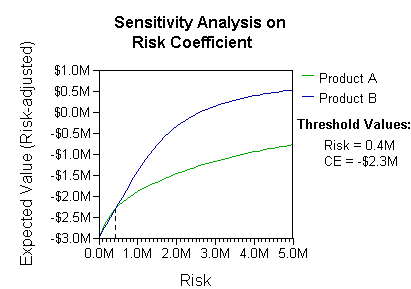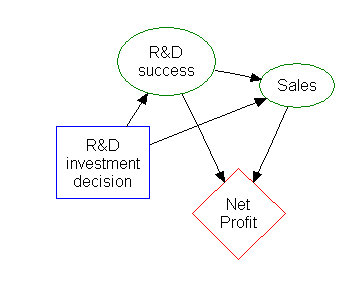A decision tree is a decision support tool that uses a tree-like graph or model of decisions and their possible consequences, including chance event outcomes, resource costs, and utility. It is one way to display an algorithm.
Decision trees are commonly used in operations research, specifically in decision analysis, to help identify a strategy most likely to reach a goal, but are also a popular tool in machine learning.
Contents
[hide]Overview[edit]
A decision tree is a flowchart-like structure in which each internal node represents a "test" on an attribute (e.g. whether a coin flip comes up heads or tails), each branch represents the outcome of the test, and each leaf node represents a class label (decision taken after computing all attributes). The paths from root to leaf represent classification rules.In decision analysis, a decision tree and the closely related influence diagram are used as a visual and analytical decision support tool, where the expected values (or expected utility) of competing alternatives are calculated.
A decision tree consists of three types of nodes:[1]
- Decision nodes – typically represented by squares
- Chance nodes – typically represented by circles
- End nodes – typically represented by triangles
Decision trees, influence diagrams, utility functions, and other decision analysis tools and methods are taught to undergraduate students in schools of business, health economics, and public health, and are examples of operations research or management science methods.
Decision tree building blocks[edit]
Decision tree elements[edit]
Drawn from left to right, a decision tree has only burst nodes (splitting paths) but no sink nodes (converging paths). Therefore, used manually, they can grow very big and are then often hard to draw fully by hand. Traditionally, decision trees have been created manually — as the aside example shows — although increasingly, specialized software is employed.Decision rules[edit]
The decision tree can be linearized into decision rules,[2] where the outcome is the contents of the leaf node, and the conditions along the path form a conjunction in the if clause. In general, the rules have the form:- if condition1 and condition2 and condition3 then outcome.
Decision tree using flowchart symbols[edit]
Commonly a decision tree is drawn using flowchart symbols as it is easier for many to read and understand.Analysis example[edit]
Analysis can take into account the decision maker's (e.g., the company's) preference or utility function, for example:The basic interpretation in this situation is that the company prefers B's risk and payoffs under realistic risk preference coefficients (greater than $400K—in that range of risk aversion, the company would need to model a third strategy, "Neither A nor B").
Influence diagram[edit]
Much of the information in a decision tree can be represented more compactly as an influence diagram, focusing attention on the issues and relationships between events.Association rule induction[edit]
Decision trees can also be seen as generative models of induction rules from empirical data. An optimal decision tree is then defined as a tree that accounts for most of the data, while minimizing the number of levels (or "questions").[4] Several algorithms to generate such optimal trees have been devised, such as ID3/4/5,[5] CLS, ASSISTANT, and CART.Advantages and disadvantages[edit]
Among decision support tools, decision trees (and influence diagrams) have several advantages. Decision trees:- Are simple to understand and interpret. People are able to understand decision tree models after a brief explanation.
- Have value even with little hard data. Important insights can be generated based on experts describing a situation (its alternatives, probabilities, and costs) and their preferences for outcomes.
- Allow the addition of new possible scenarios.
- Help determine worst, best and expected values for different scenarios.
- Use a white box model. If a given result is provided by a model.
- Can be combined with other decision techniques.
- For data including categorical variables with different number of levels, information gain in decision trees is biased in favor of those attributes with more levels.[6]
- Calculations can get very complex, particularly if many values are uncertain and/or if many outcomes are linked.
See also[edit]
References[edit]
- Jump up ^ Kamiński, B.; Jakubczyk, M.; Szufel, P. (2017). "A framework for sensitivity analysis of decision trees". Central European Journal of Operations Research. doi:10.1007/s10100-017-0479-6.
- Jump up ^ Quinlan, J. R. (1987). "Simplifying decision trees". International Journal of Man-Machine Studies. 27 (3): 221. doi:10.1016/S0020-7373(87)80053-6.
- Jump up ^ K. Karimi and H.J. Hamilton (2011), "Generation and Interpretation of Temporal Decision Rules", International Journal of Computer Information Systems and Industrial Management Applications, Volume 3
- Jump up ^ R. Quinlan, "Learning efficient classification procedures", Machine Learning: an artificial intelligence approach, Michalski, Carbonell & Mitchell (eds.), Morgan Kaufmann, 1983, p. 463-482. doi:10.1007/978-3-662-12405-5_15
- Jump up ^ Utgoff, P. E. (1989). Incremental induction of decision trees. Machine learning, 4(2), 161-186. doi:10.1023/A:1022699900025
- Jump up ^ Deng,H.; Runger, G.; Tuv, E. (2011). Bias of importance measures for multi-valued attributes and solutions. Proceedings of the 21st International Conference on Artificial Neural Networks (ICANN).
Further reading[edit]
- Cha, Sung-Hyuk; Tappert, Charles C (2009). "A Genetic Algorithm for Constructing Compact Binary Decision Trees". Journal of Pattern Recognition Research. 4 (1): 1–13. doi:10.13176/11.44.
External links[edit]
| Wikimedia Commons has media related to decision diagrams. |




No comments:
Post a Comment